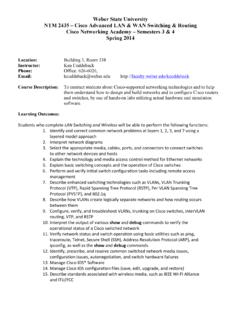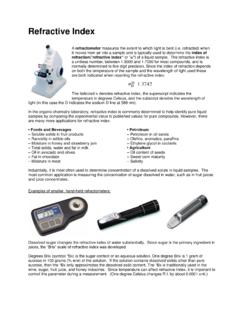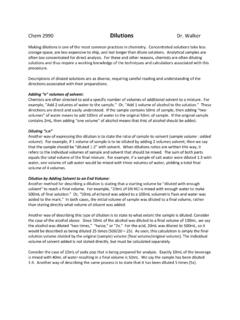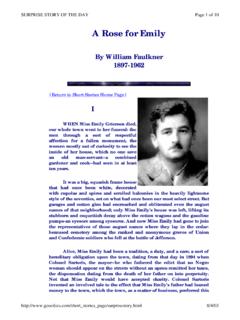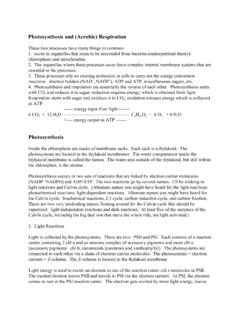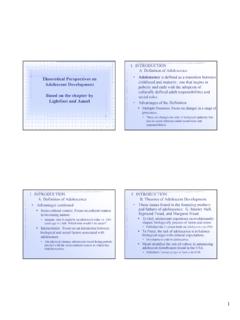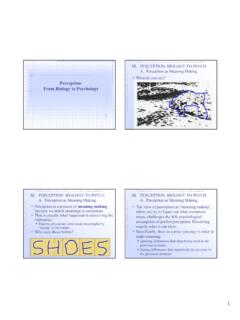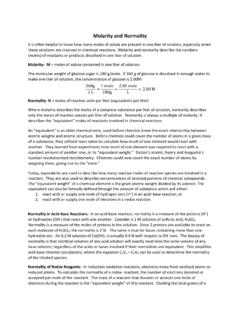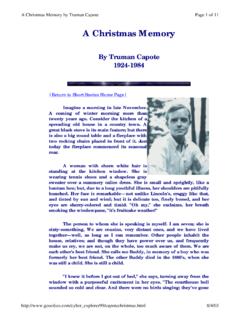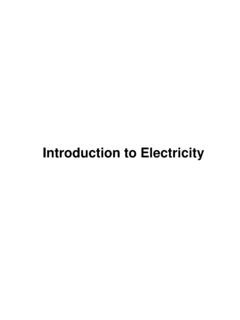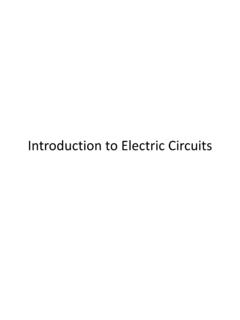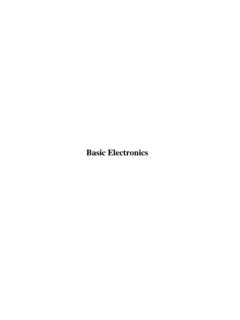Transcription of Syllabus ECE 1270 Introduction to Electric Circuits
1 Syllabus ECE 1270 Introduction to Electric Circuits Course Number and Title: ECE 1270, Introduction to Electric Circuits Credits: 4 Website: Instructor: Suketu Naik Office: WSU Campus, ET 133B Phone: (801) 626 6895 Email: (please put ECE1270 in the subject line) Office Hours: As listed on Class Time and Location: Day Class: TR 9:00-10:30am (ET133D/C) Lab Time and Location: Day Class: T 1:30-4:30pm (ET127) Text: Electric Circuits 10th edition, Nilsson & Riedel (No E Access Card Required) References: Fundamentals of Electric Circuits by Alexander and Sadiku Description: The basics of analog Circuits as an Introduction to Electronics Engineering. Concepts of voltage, current, power, resistance capacitance and inductance. circuit analysis techniques such as Kirchhoff s Laws, node voltages, and mesh currents.
2 Thevenin s and Norton s equivalent Circuits , sinusoidal steady state and phasors. Prerequisite: MATH 1210 Student Learning Outcomes: The students will demonstrate: 1. A knowledge of node and mesh analysis techniques. 2. A knowledge of Thevenin and Norton equivalent Circuits . 3. An understanding of loading effects. 4. An understanding of passive circuit elements. 5. An ability to conduct electrical tests on Circuits . Student Assessment: 1. Homework assignments: 5% 2. Laboratory assignments: 20% 4. 1st Midterm examination: 25% 5. 2nd Midterm examination: 25% 6. Final examination: 25% Grades: Grades will be assigned as follows based on the weighted average of exams, labs, and homework as shown above. Grading scale may be normalized to the highest grade in the class per the instructor s discretion.
3 Please note that C or better is required in order to obtain BSECE degree. If you fail to meet this requirement, you will have to retake the class. A > 93% C+ 77-80% A- 90-93% C 73-77% B+ 87-90% C- 70-73% B 83-87% D 60-70% B- 80-83% F < 60% Topic Outline: 1. Chapter 1: circuit Variables 2. Chapter 2: circuit Elements 3. Chapter 3: Simple Resistive Circuits 4. Chapter 4: Techniques of circuit Analysis 5. Chapter 5: The Operational Amplifier 6. Chapter 6: Inductance, Capacitance, and Mutual Inductance 7. Chapter 9: Sinusoidal Steady-State Analysis 8. Chapter 10: Sinusoidal Steady-State Power Calculations Schedule: Please refer to the class website for the tentative list of class schedule, homework problems, and the labs: Homework: Homework assignments will be posted on the schedule website (see the above link) and will be due one week after it is assigned (Example: If it is assigned on Tue 9/1, it will be due on Tue 9/8 at 9am).
4 Late homework policy: 50% credit after the due date and before the test. All past homeworks are due on or before the test (pertaining to those homeworks). No credit will be given after the test. Homework will not be graded unless put in the proper format (see the format below) on engineering paper. It must be clear and well organized. Use only one side of each sheet. Write your name, the class number (ECE 1270) and assignment number on the top (see the format below). Do not use multiple columns; separate problems with horizontal bars and box each answer. All homework and labs must be submitted electronically using the upload link as provided on the website. Homework Grading: Points per homework problem will be determined by the instructor. Full credit will be given for all the work and the correct answer.
5 Homework that does not conform to the format (see the format below) will be penalized. Laboratory Experiments: Laboratory experiments will be performed periodically throughout the semester at the discretion of the instructor. You must make all requested calculations and measurements specified and record for a laboratory report. You must assemble and write up your own report. Your report should show and include original work such as changes in the schematic or different types of related designs you tried. You will be expected to be honest in reporting your data. If you do not get the same results as expected, then you should try to understand and explain why your data was different from what you expected. You need to spend time troubleshooting your Circuits , and in your report, include a little section that explains what you did and what you learned.
6 Include and show any calculations you did. Most important is a conclusion section that ties everything together and explains what was learned. Things that cannot be read will cause you to lose points. Lab reports will be required for each lab (see the format below). Append your lab reports in an electronic document and use it as a lab book. Lab reports must be submitted online using the upload link. For your information, additional lab book guidelines are also provided below. It is optional to maintain a hard copy of the lab book. Course Fees: The purpose of the course fee for ECE1270 is to purchase or maintain equipment, parts and software licenses for this course. Services for Students with Disabilities: Any student requiring accommodations or services due to a disability must contact Services for Students with Disabilities (SSD) in Room 181 of the Student Services Center.
7 SSD can also arrange to provide course materials (including the Syllabus ) in alternative formats if necessary. Cheating and plagiarism: Just don Homework Format Lab Report Format (make sure to write your name) Lab 1: Title of the Lab Cleopatra Egyptian and Harry Houdini Jan 26, 2015 1. Introduction Write a short Introduction that summarizes the activities performed in the lab, and explains how they relate to concepts covered in the lectures. You should also include the circuit (s) and label them as Fig. 1: title, etc. 2. Analysis Provide the details of your lab calculations. If you wish, you may provide only the final results in this section and include the detailed calculations in the Appendix in handwritten form. Be succinct. Details of supporting calculations can be handwritten and included in the appendix as long as they are clearly labeled.
8 3. Simulations and Measurements Provide your Simulated and Measured results in this section. You can either do side by side comparison or you can include them in sequence. Measured results should be provided in tables or individually with units specified, and appropriate labeling should be provided as to which part of the lab the results pertain to. Plots from simulations and measurements should be captured as image files and included as figures (see Fig. 1 as an example). Fig. 1: Example figure for simulation results of disappearance act by Houdini. 4. Conclusion Write a short conclusion that describes what you have learned by performing this lab. 5. Appendix You may include handwritten details of supporting calculations in this section as long as they are clearly labeled.
9 Additional Lab Book Guidelines Note: Hard Copy is Optional 1. Keeping a proper lab book is essential to establish ownership of intellectual property (which is the primary output of all engineering). Try to follow these guidelines outside of this class as a good practice to maintain lab books. 2. Start each lab at the top of a new page. For each lab, write your name, lab number, and the title at the top of the page. See the format below. 3. Use the first page in your lab book as table of contents. Each time you start a new lab, add an entry with its title, date and page number. See example below: ECE 1270 Lab book C. Xavier Table of Contents Lab # Title Date Page 1 Intro to Multisim 9/3/2015 3 2 DC test equipment 9/10/2015 10.
10 4. Conclude each lab with a summary or conclusion that briefly describes how the circuit /code/etc performed. Summary or conclusion should mention the problems you encountered and if/how you addressed it. 5. Don t use three ring binders or spiral bound notebooks. Use a proper bound Lab book. 6. Number all pages! Number them by hand if necessary. 7. Printed work can be included in the book. Make sure to tape it neatly or glue it properly. 8. Sign or initial and date each page. If a page contains work from different dates, it should be separated with horizontal lines and each section (from different dates) should be signed or initialed and dated. 9. Don t leave blank pages. If you don t want to use a page, then draw a diagonal line from one corner to the other. Initial and date the blank page.
